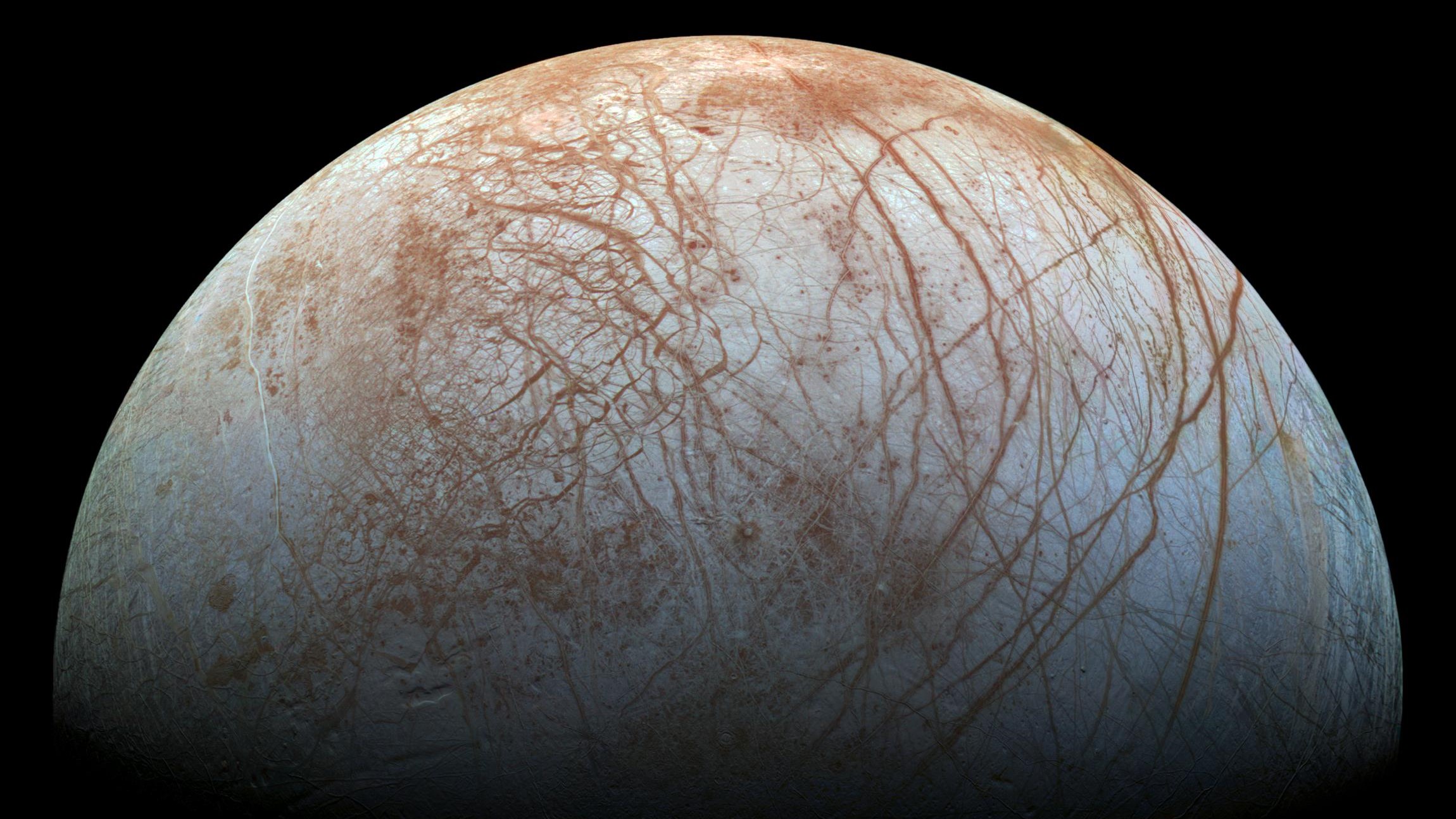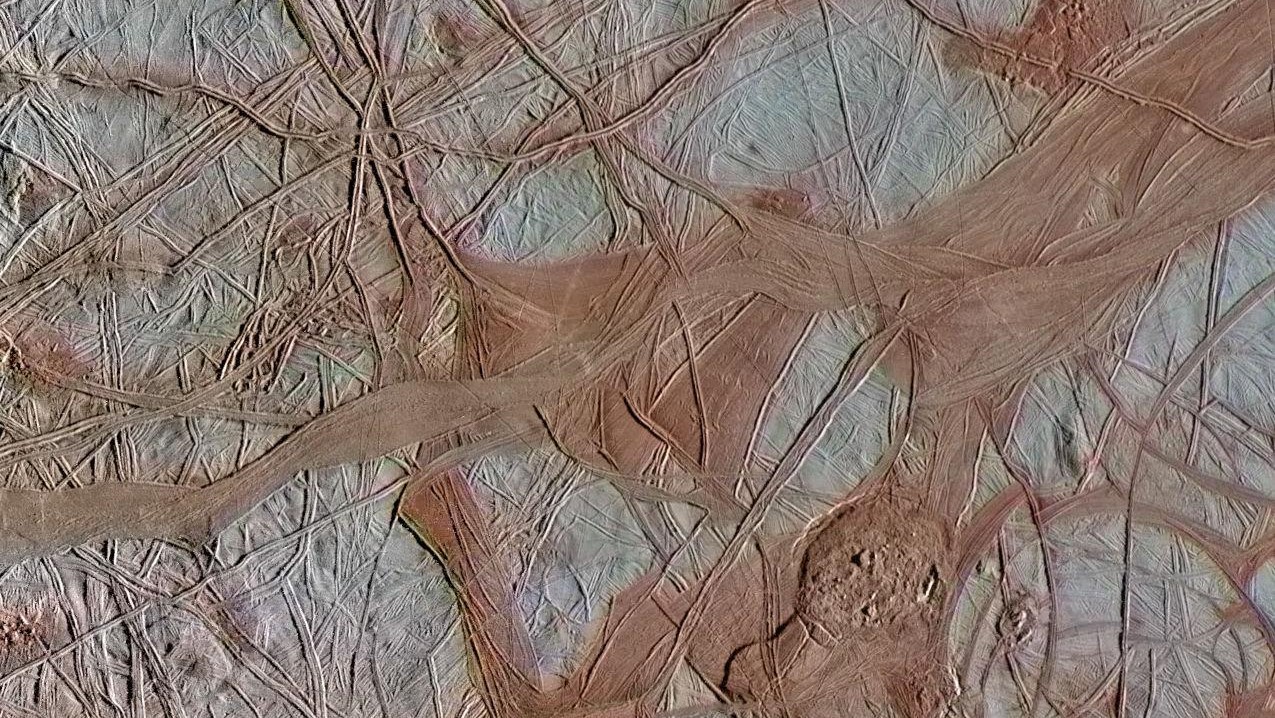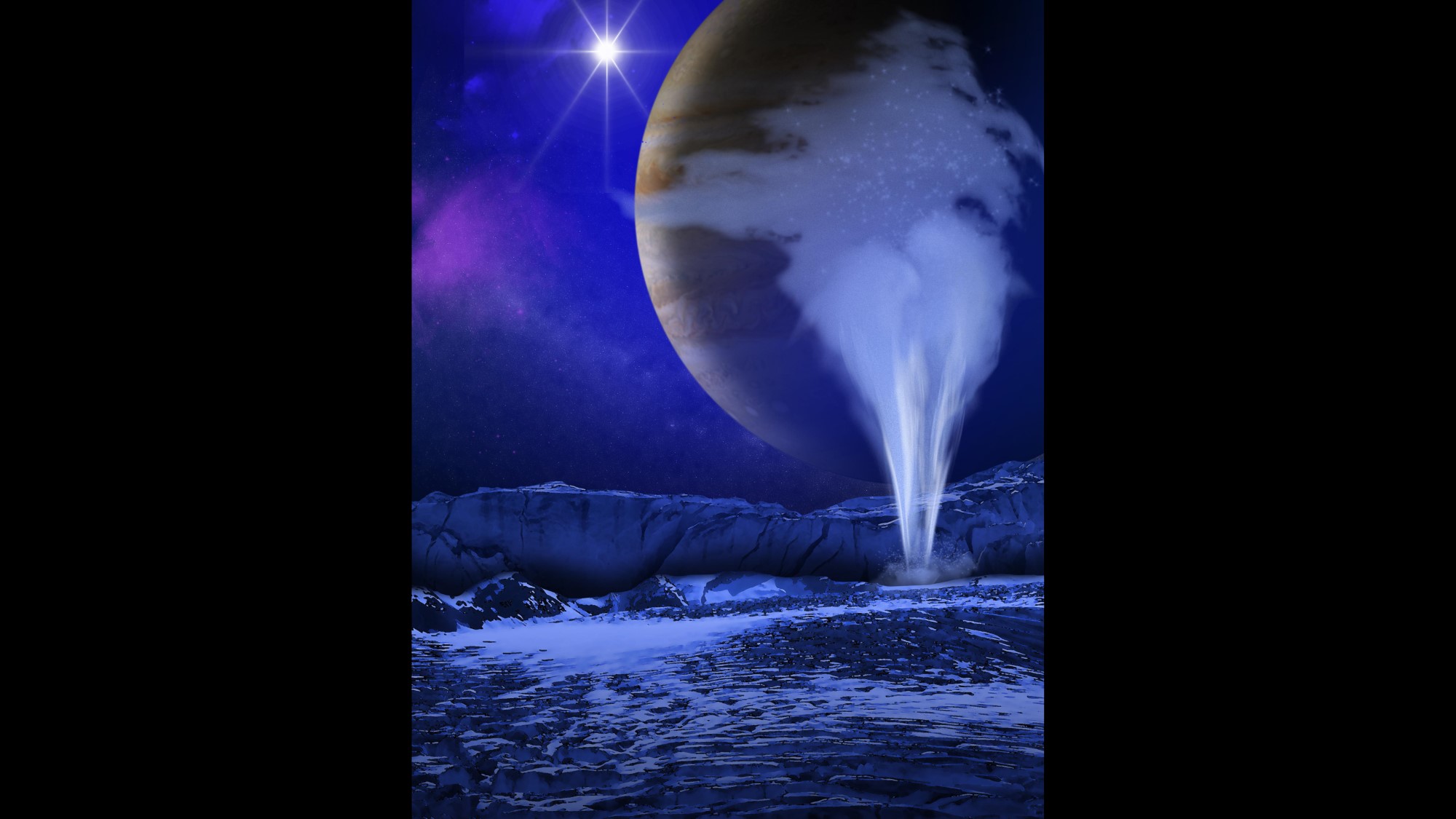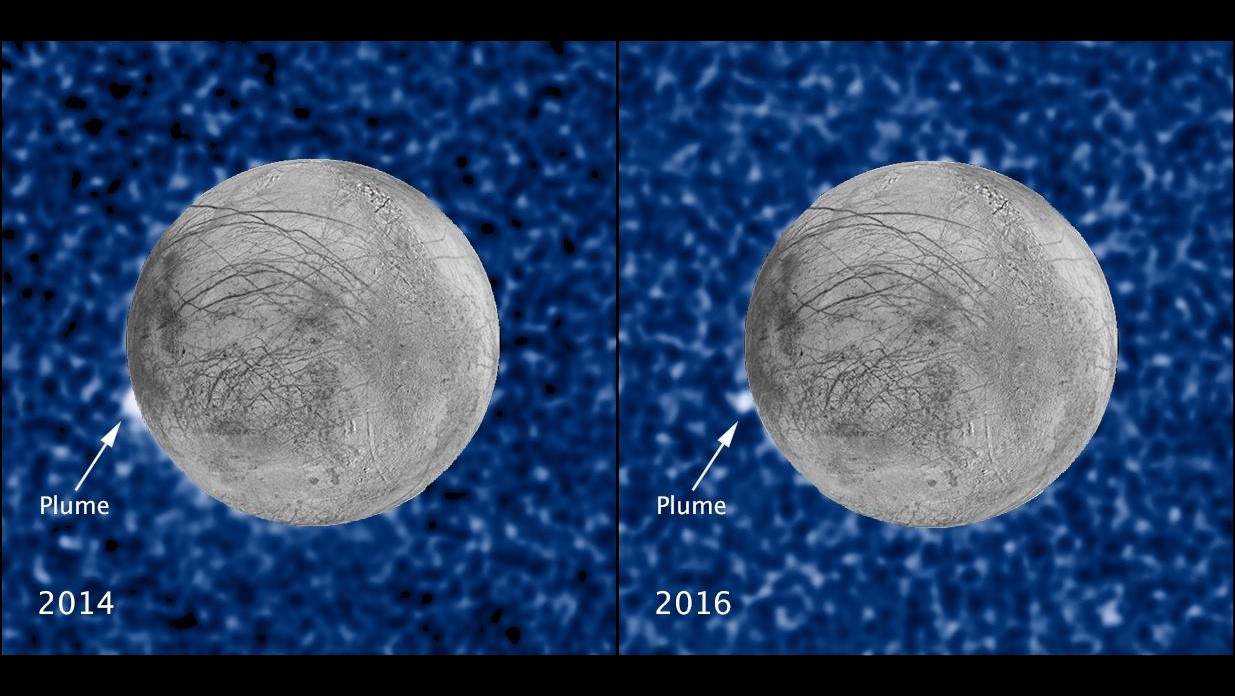NASA's Juno probe will peer beneath the icy crust of Jupiter's moon Europa
Water below the icy moon's surface is a key target for Juno's close flyby.

On Sept. 29, NASA's Juno probe will perform the closest flyby of Jupiter's icy moon Europa in over 20 years as the spacecraft embarks on a mission to probe deep into Europa's ice in search of pockets of liquid water.
Europa contains a global ocean beneath a solid crust of ice, making this moon one of the most intriguing places in the solar system to search for extraterrestrial life and one of astrobiologists' top priorities. Although Juno won't be able to tell us whether Europa harbors alien life, it will teach us more about the moon's icy crust, such as how thick it is and whether there are any subsurface pockets of liquid water that could reach the surface.
Juno arrived at Jupiter in July 2016, and its mission has focused on studying Jupiter's atmosphere, from the heights of its ruddy-brown cloud tops to the depths of the lower cloud layers hundreds of miles down, as well as learning about the gas giant's powerful magnetic field and its interior structure all the way down to its core.
In 2021, NASA granted Juno a mission extension and gave it a new aim: to study some of Jupiter's moons. In June 2021, the spacecraft flew within 645 miles (1,038 kilometers) of Ganymede, which, at 3,273 miles (5,268 km) across, is the largest moon in the solar system. Next, it will be Europa's turn, with Juno set to hurtle past the moon at just 220 miles (355 km) above Europa's surface. Juno won't see the entire moon but rather a small fraction of the surface. Yet Juno's cameras have a wide field of view — a bit like that from a smartphone camera — allowing the spacecraft to take in more of the landscape than a normal camera could.
Peering beneath the ice
Juno's work at Europa is considered a "scouting mission" for NASA's forthcoming Europa Clipper mission, Scott Bolton, associate vice president of the Southwest Research Institute Space Science and Engineering Division and principal investigator for the Juno mission, told Space.com. "But we're still going to be doing quite a lot of science at Europa."
Key to that science will be Juno's microwave radiometer (MWR). "This is a new kind of instrument that we invented to see beneath the clouds of Jupiter," Bolton said. "'But we can apply the same instrument to an icy satellite and see into the ice a little bit."
Get the Space.com Newsletter
Breaking space news, the latest updates on rocket launches, skywatching events and more!
The MWR operates at six wavelengths and can detect thermal emission from below the icy surface. Just how deep it can detect such emission depends on the level of impurities in the ice. The purer the ice is, the deeper into the ice the MWR will be able to "see."
Although the findings from Juno's Ganymede flyby are still being written up, Bolton revealed that when Juno directed the MWR at Ganymede, the instrument confirmed that the giant moon's icy crust was very thick.
Europa might be a different story, at least at certain points on the moon. Scientists hope to one day drill through the ice, into the moon's dark, subterranean ocean. The ice crust is expected to be 19 miles (30 km) deep, at least in most regions, but the crust may be thinner in some areas.
Related: Chaos reigns in detailed new views of Jupiter's icy moon Europa

Previous missions that have imaged Europa — the Voyager 1 and Voyager 2 spacecraft, and the Galileo orbiter — found that parts of the moon's surface are stained by material that seems to have welled up from below. Juno's infrared camera and spectrometer will analyze the composition of this material to determine whether it is made from salts or organic molecules.
One theory is that pockets of water can form in the subsurface, either through liquid convectively rising up through the ice shell, or by the ice in the shell melting, perhaps as a result of stresses placed on it by Jupiter's gravitational tides. The MWR should be able to tell whether there are any pockets of water close to the surface.
"When we were developing Juno, we didn't really think about going close to the icy satellites; we were completely focused on Jupiter," Bolton said. "Now that we're looking at the moons for our extended mission, it has become obvious that the microwave radiometer works incredibly beautifully at icy bodies as well as gas giants, so I believe it will become a mainstream workhorse in future planetary exploration."
Related to the possibility of liquid water close to the surface is controversial evidence for erupting geysers of water that climb high above the surface and into space. In 2013, the Hubble Space Telescope detected plume-shaped clouds of hydrogen and oxygen (which, when combined, make water) and, in 2016, saw the possible silhouette of these plumes. Scientists perusing archived data from the Galileo spacecraft found that it had measured subtle perturbations in Jupiter's magnetosphere close to Europa that could be the result of charged particles in the plume deflecting the giant planet's magnetic field.

In 2021, scientists detected enough water vapor being released over Europa to fill an Olympic-sized swimming pool in just minutes. However, how that water vapor got there remains uncertain, as scientists have so far failed to confirm the existence of water geysers.
Could Juno make the first confirmed detection of a geyser during its flyby? "It's a long shot," Bolton said. "If the plumes do exist, then we have to get lucky and have them going off while we fly past, and they have to be in a place that we just happen to be looking at."
Still, even if Juno doesn't spot a plume in action, the spacecraft might see a geological feature on the surface that's emitting water vapor, analogous to the "tiger stripes" on Saturn's icy moon Enceladus that release their own water geysers. Alternatively, Juno's navigation cameras will hunt for icy particles drifting back down to Europa's surface, reflecting and scattering light.
Juno's polar orbit around Jupiter, flying over the north pole and then the south pole, means that it will approach Europa from a high inclination, giving the spacecraft views of the polar regions of the moon for the first time. In contrast, previous missions hugged the plane of the moons and focused on their equatorial regions. Juno's orbit also means that this is the only chance the spacecraft will get to observe Europa up close.

"What's happening is, Juno's orbit is now being twisted by Jupiter's gravitational field," Bolton said. "We've always crossed the equator, but as we get closer to Jupiter, the point at which we cross the equator is moving inward."
Juno crossed Jupiter's equator at the distance of Ganymede — 665,000 miles, 1.07 million km) in the summer of 2021. Now, the spacecraft is crossing Jupiter's equator at the distance of Europa — 383,000 miles (617,000 km). And in December 2023 and February 2024, Juno will cross Jupiter's equator at the distance of its volcanic moon Io — 262,000 miles (422,000 km) — and perform two close flybys, both within 932 miles (1,500 km).
Juno's extended mission will last until 2025, at which point mission scientists will have to make an assessment: whether the spacecraft has enough propellant to keep pointing its antenna toward Earth and is in good enough condition to keep going, or whether the mission will have to end.
"I imagine that NASA would entertain another extension if the spacecraft is healthy," Bolton said.
The prime issue is radiation. Juno's orbit around the giant planet is elliptical, and every time it reaches perijove — meaning its closest point to Jupiter — it receives a large dose of radiation from the charged particles that are trapped in Jupiter's powerful magnetosphere and routinely hammer the surface of the planet's moons. To withstand this radiation, Juno is built "like an armored tank with shields,' Bolton said, "but eventually, our shields will no longer hold, to use Star Trek language, and the radiation will start to harm Juno's electronics."
Juno's encounter with Europa may be its only shot, but it will not be the last spacecraft to visit Jupiter's icy moons. NASA's long-awaited Europa Clipper mission is scheduled to launch in October 2024 and to arrive in orbit around Jupiter in April 2030. Europa Clipper will perform nearly 50 close flybys of Europa to fully characterize the moon and follow up on Juno's search for pockets of liquid water in the subsurface that could potentially support life. Meanwhile, the European Space Agency's Jupiter Icy moons Explorer (JUICE) will launch in April 2023, for arrival at Jupiter in July 2031, on a mission to study Europa, Ganymede and Callisto.
Follow Keith Cooper on Twitter @21stCenturySETI. Follow us on Twitter @Spacedotcom and on Facebook.
Join our Space Forums to keep talking space on the latest missions, night sky and more! And if you have a news tip, correction or comment, let us know at: community@space.com.

Keith Cooper is a freelance science journalist and editor in the United Kingdom, and has a degree in physics and astrophysics from the University of Manchester. He's the author of "The Contact Paradox: Challenging Our Assumptions in the Search for Extraterrestrial Intelligence" (Bloomsbury Sigma, 2020) and has written articles on astronomy, space, physics and astrobiology for a multitude of magazines and websites.









